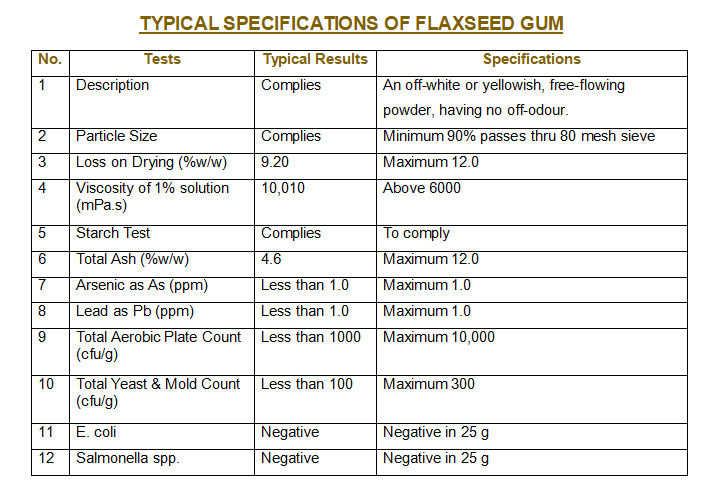Flaxseed gum (FLAX-G) or Linseed gum is a by-product of flax (Linum usitatissimum L.) meal production, that is useful as a food thickener, emulsifier, and foaming agent. It can be used in foods & drug delivery systems. Flaxseed gum is a soluble dietary fibre present in flaxseed hull.
Flaxseed gum is typically obtained by hot-water extraction from flaxseed hull or whole seed, followed by precipitation with ethanol. Flaxseed gum includes complex polymer structures that contain bioactive compounds. The flaxseed gum content varies between 10-15% of the seed mass. Due to the complicated polymer structure of flaxseed gum & the presence of bioactive compounds, extraction temperature plays an important role in gum appearance, physicochemical properties, and functional properties. Low-temperature extraction can avoid the denaturation of bioactive compounds and save energy costs but may give lower gum yield, whereas higher-temperature extraction can inactivate microorganisms and enzymes but may lead to the formation of undesirable compounds and protein denaturation.
Flaxseed gum is composed of 80% neutral and acidic polysaccharide and 9% protein. The neutral monosaccharides consist of xylose, glucose, arabinose, and galactose, while acidic monosaccharides consist of rhamnose, galactose, fucose, and galacturonic acid. The protein in flaxseed gum is predominantly conlinin.

Flax seed gum powder
Hydrocolloidal flaxseed gum exhibits multifunctional properties including thickening, gelling, emulsifying, binding, stabilizing, texture modifying and foaming ability. It also shows stability against pH, heat & freeze-thaw cycles. It serves as a substitute for Pectin, Gum Acacia, Alginates, Agar etc.
The flaxseed gum absorbs water slowly to form a dispersion with low viscosity ultimately dissolving in water. Below 1 to 2 g/L concentration it completely dissolves. Its solubility is ranked higher than that of guar gum. A 0.5% solution of the flaxseed gum at 15°C dissolves 70% of the gum & at 95°C the solubility reaches about 90%.
The apparent viscosity of the solution increases with increased dissolution, and after reaching the maximum value at a constant temperature, it decreases. The time required for 1% flaxseed gum solution to reach a maximum viscosity (& dissolution) of 1600 Pa.s is as follows: At 40°C it requires 8 hours; At 50°C it requires 6 hours; At 60-70°C it requires 4 hours; At 80°C requires 2 hours.
It is of significance to note that the viscoelasticity changes: at high dissolution temperatures the gel characteristics are stronger.
The viscosity increases with increase in percentage & decreases with increase in shear rate.
Under acidic conditions the apparent viscosity decreases whereas under alkaline conditions it decreases. In neutral conditions, maximum viscosity is attained.

The flaxseed gum solutions show exceptional emulsification of vegetable oils when compared to gum acacia, xanthan gum, sodium CMC, sodium alginate or gelatin.
Flaxseed gum has gelling property like those of gelatin, gum carrageenan, pectins, starch etc. Synergistic gelling can be found with these and xanthan or locust bean gum.
Aqueous solution of flaxseed gum forms an excellent stable foam at any concentration. A flocculent gum precipitate is formed when the solution has 50-60% alcohol added to it. The foam can be destroyed only if it is heated to 90°C for half an hour.

When the amount of flaxseed gum added to the flour is between 0.1% and 0.4%, the gluten strength of the dough is the best, making the noodles chewy, smooth and not soupy. The addition of flaxseed gum increases the water absorption rate of the dough, prolongs the forming and stabilization time of the dough, thereby reducing the degree of weakening and making the dough more stable.
The amount of flaxseed gum added in ice cream production is 0.05%, and the expansion rate of the product after curing and freezing is above 95%. Its taste is delicate, smooth, palatable, and has no peculiar smell. The structure of ice cream after freezing is still soft and moderate, and the ice crystals are very small. Addition of flaxseed gum also prevents the formation of coarse ice crystals.
When the content of flaxseed gum in the compound jelly powder is 25%, and the amount of jelly powder is 0.8%, the gel strength, viscoelasticity, transparency, water holding capacity and other properties of the obtained jelly are the best, and the taste of the jelly is the best.



GMO Declaration : Flaxseed gum is not produced using raw materials of a genetically modified origin. The product does not come in contact with genetically modified organisms during its processing, manufacture or handling.
Storage Conditions : Store in cool, dry place.
Best before : 24 months if stored as above in unopened pack.